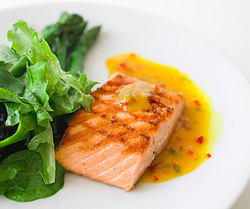Diabetes and Lifestyle Considerations
Healthy Eating to Control Diabetes
There isn’t one specific “diabetes diet” that you can follow, but creating a healthy eating plan is one of the best ways to manage the disease. It’s important for patients to work with their diabetes healthcare team to determine the best diet for their needs.
If you have type 1 or type 2 diabetes, your primary care provider, endocrinologist, nutritionist or dietitian can help you develop a meal plan with a set amount of calories largely from:
- Carbohydrates: Found mostly in vegetables, fruits, dairy products, bread, pasta and cereal
- Protein: Found mostly in meat, poultry, fish, tofu, beans and dairy products
- Fat: Includes saturated (butter, lard) and unsaturated fats (olive oil, nuts)
Type 1 and Type 2 Diabetes
With type 1 diabetes, your body doesn’t produce insulin. Insulin is secreted by the pancreas when food is absorbed, so as food accumulates in the blood in someone with type 1 diabetes, sugar levels get too high. If you have type 2 diabetes, your pancreas doesn’t produce enough insulin, or your body does not properly use the insulin it makes, causing glucose (sugar) to build up in your blood.
If you have type 1 or type 2 diabetes, it’s important to know that the impact goes beyond chronic hyperglycemia. Diabetes can cause diabetic retinopathy (a leading cause of blindness), diabetic neuropathy (nerve damage that can lead to amputation), increase your risk of cardiovascular disease and stroke and more.
Type 2 diabetes can also contribute to being overweight or obese. Nearly 90% of people with type 2 diabetes are overweight or obese. In fact, it may be the single best predictor of type 2 diabetes.
Treating Diabetes with Diet
Your diabetes diet plan depends on the type of diabetes that you have, your lifestyle and whether you’re obese or not. Your diabetes healthcare team will probably recommend a diet that includes complex carbohydrates (oatmeal, brown rice, quinoa), protein, lots of fruits and vegetables, and unsaturated fats.
Increasing the amount of fibre in your diet can also be beneficial. High-fibre foods can decrease hyperinsulinemia, improve glycemic control and create a sense of fullness between meals.
If you have type 1 or 2 diabetes, you will probably need to avoid simple carbohydrates (cookies and chips), trans fat and soda. Meal timing is very important for people with type 1 diabetes, so when you eat is just as important as what you eat.
If you have type 2 diabetes and obesity, even a moderate, sustained weight loss of 5-10 percent of your body weight may reduce the need for some diabetes medications, improve how the body uses insulin and decrease fasting glucose concentrations.
How Can Patients Take Control of Their Health?
- Eat at regular times and have healthy snacks as needed. Your diabetes healthcare team can help you determine when and what to eat.
- Choose high fibre foods. High fibre foods will help control blood glucose levels, lower cholesterol and make you feel full.
- Drink plenty of water and limit juice and soft drinks.
- A healthy exercise plan is important in diabetes management. Also, if you’re obese and have type 2 diabetes, weight loss can help control and lower blood glucose levels and may even eliminate the need for certain diabetes medications. Talk to a diabetes exercise specialist to create a customized program that’s right for you.
Talk to a Nurse Educator or endocrinologist to learn more about blood glucose management.

